You are going to love this time-saving bread recipe. 2 Hour No Knead Bread is perfect for round loaves and loaf pans, so you can have artisan bread or sandwich bread ready in no time.
Recipe: $1.15 | Per Serving: $0.12 | Servings: 10 slices
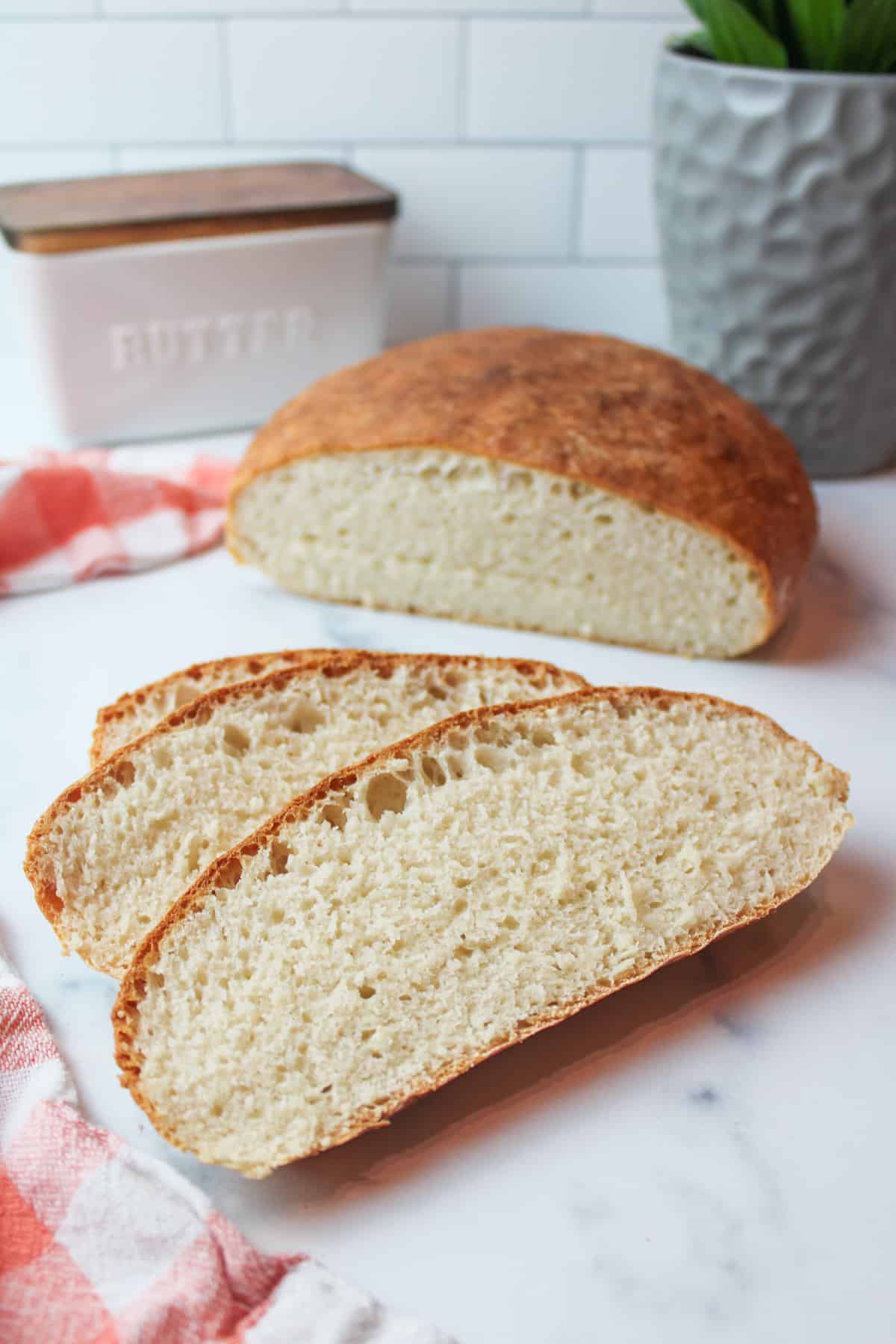
There's nothing like the smell of good homemade bread! Unfortunately, bread can often require a lot of time and work to knead and rise. This recipe offers a great alternative to those in a hurry.
If you have more time on your hands, make sure to check out my 5 Ingredient White Bread Recipe too! It takes a little more kneading and patience, but it's perfect for sandwiches.
This bread pairs well with everything from lunch meat to Copycat Texas Roadhouse Butter, Sugar Free Strawberry Jam, and Sugar Free Blueberry Jam.
Serve it up sliced with butter the next time you enjoy a bowl of Cheesy Potato Soup or turn it into lunch for the week. There's nothing better than the taste of homemade bread!
Jump to:
🍯 Why This Recipe Works
- Minimal ingredients and effort. While you don't need much to make bread at home, you can feel even better knowing that you don't need as much time and labor to bring the taste of freshly baked bread into your home.
- Two ways to bake it. You can make this bread in a loaf pan for sliced sandwich bread, or you can bake it on a baking sheet for a round artisan-looking loaf.
- It's nice and chewy. While this bread isn't as chewy as homemade sourdough bread, it does still have a nice texture. From the chewy crust to the soft, chewy centers, this bread is one of my favorites for making on soup nights. It holds up well to being dunked in chowders, broths, and Tomato Soup Chili.
🥘 Ingredients
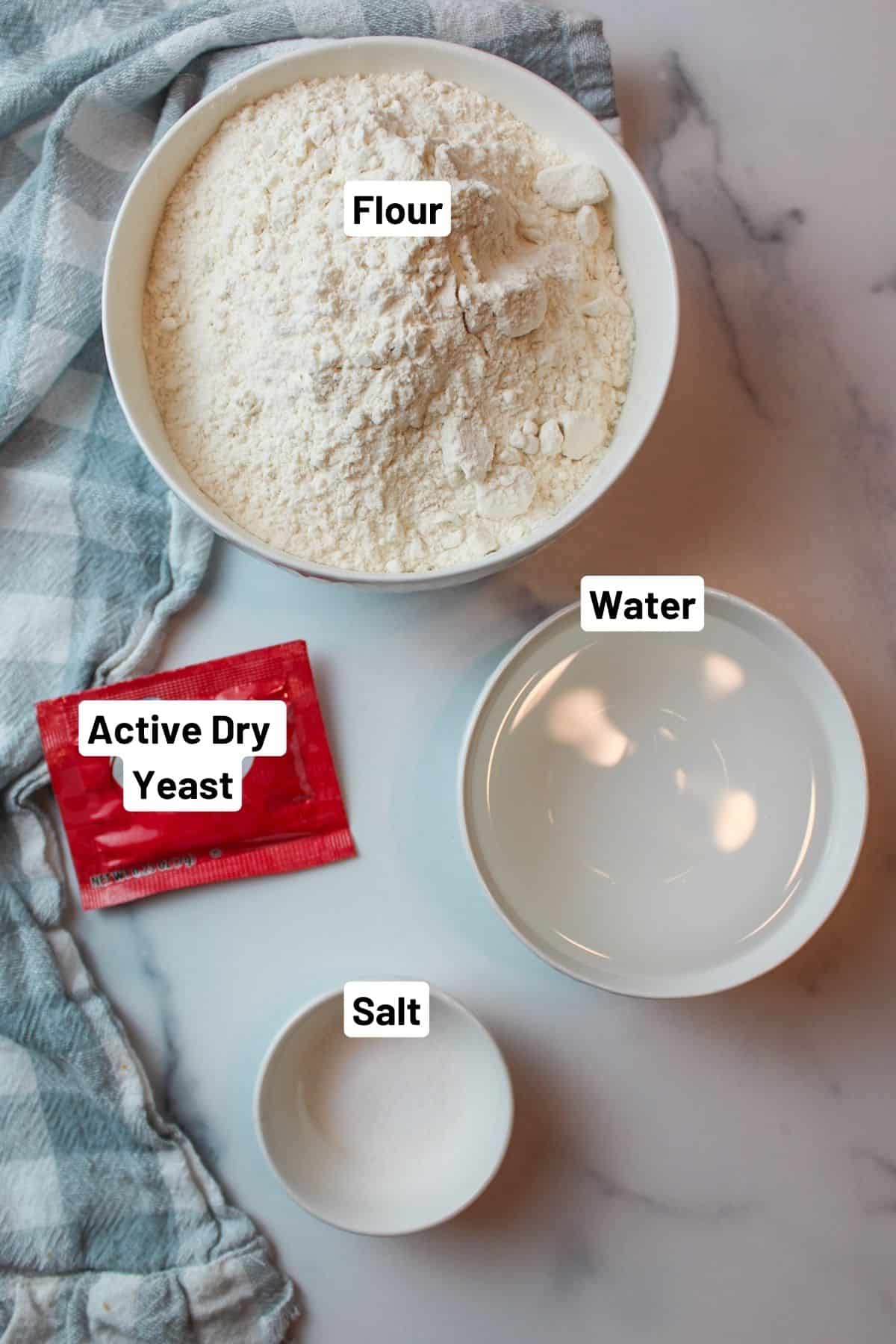
Ingredient Notes:
Flour- You'll need some bread flour or all-purpose flour for the gluten structure and base of this recipe. You'll also need a few extra tablespoons of flour for dusting the counter with as you prepare the dough.
Yeast- Use instant or rapid-rise yeast to help our bread proof more quickly.
Water- You'll need warm water to help hydrate the dough and activate the yeast. The ideal temperature will be about 110F.
For specific ingredients and measurements, please see the recipe card below.
🧾 Substitutions
Flour. You can use all-purpose flour or bread flour for this recipe. Please note that if using bread flour, you may need additional water to hydrate the dough, so if you find your dough is dry, add in a tablespoon of warm water at a time until the consistency is correct.
🔪 Instructions for 2 Hour No Knead Bread
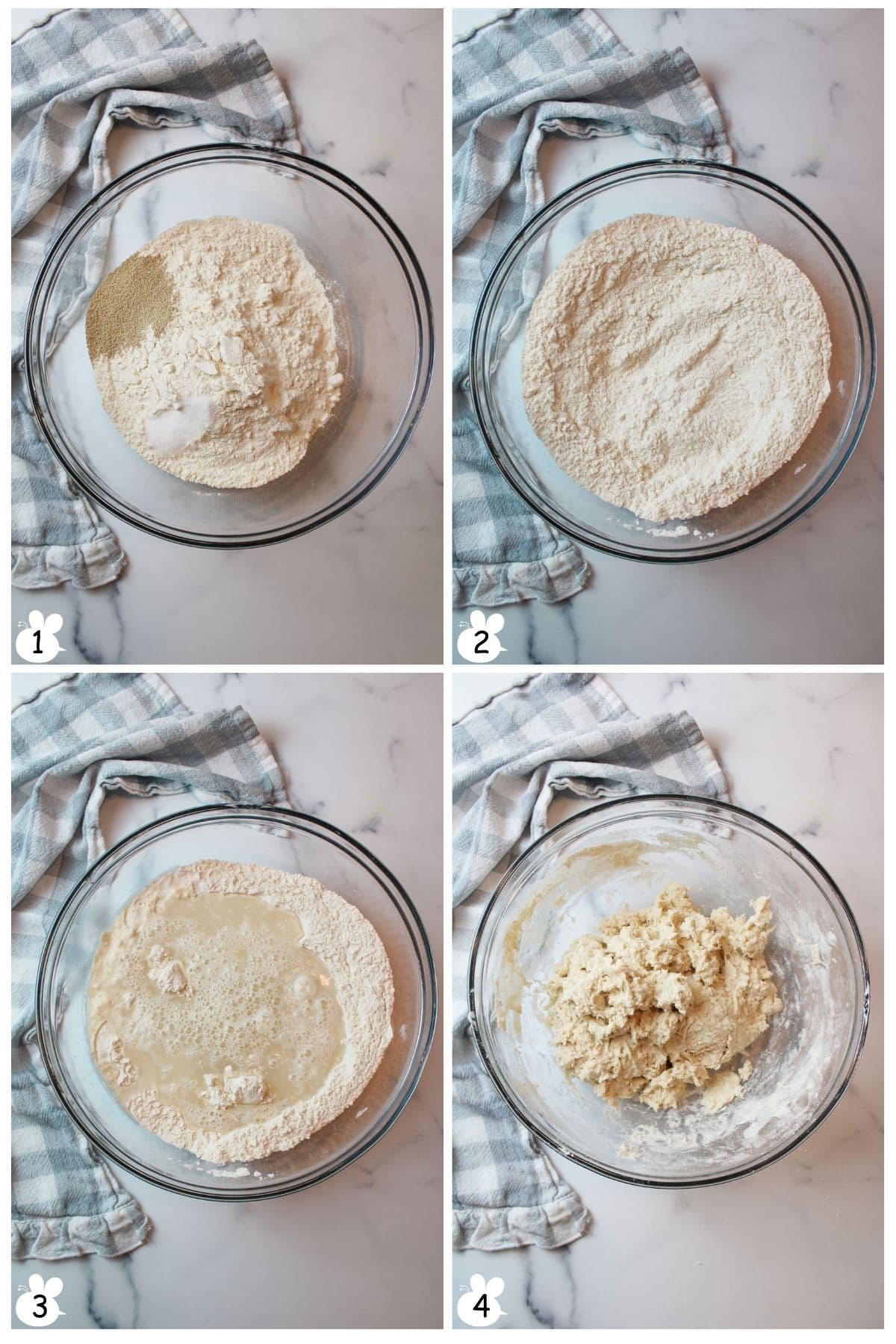
Step 1: Add the flour, yeast, and salt to a large mixing bowl (Image 1).
Step 2: Whisk well to combine (Image 2).
Step 3: Add in your warm water (Image 3).
Step 4: Stir until it's well combined (Image 4). Cover with plastic wrap and let rest for 10 minutes.
Step 5: Sprinkle 2 tablespoons of flour onto a clean work surface.

Step 6: Dump your dough onto the floured surface (Image 5).
Step 7: Press the dough out with your hands (Image 6).
Step 8: Fold the dough over about 10 times (Image 7).
Step 9: Press it flat between each fold (Image 8).

Step 10: Gather the dough and shape it into a round ball (Image 9).
Step 11: Place onto a parchment paper lined baking sheet (Image 10) or in a greased loaf pan. Let rest uncovered for 1 hour.
Step 12: When the dough has doubled in size (Image 11), preheat the oven to 425F.
Step 13: Bake in the oven for 30-40 minutes or until the top is golden in color and the internal temperature reaches 195-200F (Image 12).
Step 14: Let the bread rest for at least 1 hour before slicing.
Serve and enjoy!

📖 Different Baking Styles
Round loaf or bread pan: You can prepare this loaf as a round loaf on a baking sheet or in a bread loaf pan. If using a bread loaf pan, just follow the steps as directed and instead of gathering the dough into ball, shape it into a log and place it into a greased 8x4 bread loaf pan. The remaining steps are the same (same rise time, bake time, etc).
🍴Recipe Tips
- Bread final temp. The bread's internal temperature should be around 190-205°F, as specified in the recipe. A difference of just 10 degrees can alter the outcome significantly.
- Bread Density Issues. If your bread turns out dense in the center, consider these factors: Did you slice it while still warm? Was it adequately baked or underbaked? Ensure thorough kneading, as these factors contribute to density.
- Proofing Dough Duration. Proofing dough time varies based on numerous factors like weather, ingredient temperature, yeast age, etc. On average, it takes 1-3 hours, though some see results in as little as 30 minutes.
- Pro Tip. Rather than fixating on time, watch for the dough's response—aim for doubling in size. Some tips:
- Cover dough with greased plastic wrap to prevent drying and trap heat.
- Place it in a warm spot; preheating the oven to 200°F for 2 minutes, then turning it off, works well. Alternatively, use a closed microwave, or oven with only the light on.
👩🏻🍳 Storage
Room Temperature: Store your homemade bread in an airtight container at room temperature for about 3-5 days. Unlike storebought bread, homemade bread lacks preservatives and is best consumed quickly.
Freezing: To extend the shelf life, wrap the bread tightly in plastic wrap and place it in an airtight container. Freeze for up to 3 months. Avoid refrigerating homemade bread, as it can cause it to dry out.
💭 Recipe FAQs
When you price it out, making your own bread can be cheaper than buying storebought. It's also tastier because there are fewer additives and fillers. Unfortunately, it doesn't last as long, so you have to eat it quickly or freeze it or later.
The main ingredients in bread are flour, salt, yeast and water. You need flour (of some kind) as the base, salt for flavor enhancement, yeast for the dough to rise (unless making sourdough) and then some liquid to hydrate the dough and activate the yeast. Sometimes sugar is added to feed the yeast, but it's not always necessary.
I recommend using active dry yeast for homemade bread recipes but my favorite yeast to use is the kind you find in jars and keep stored in the fridge as it stays freshest longest and gives the best fluff to my loaves.
Begin by baking your bread at the specified temperature in the recipe. After baking, ensure the bread cools completely before slicing to avoid a gummy texture. Cutting too soon can make the bread gummy.

❤️ More Delicious Yeast Bread Recipes
If you tried this 2 Hour No Knead Bread, please leave a ⭐️ star rating and share your feedback in the 📝 comments section below. I would truly appreciate it!
📖 Recipe
2 Hour No Knead Bread
Ingredients
- 3 cups all purpose flour, or bread flour ($0.75)
- 2 teaspoons active dry yeast (one packet) ($0.38)
- 1 teaspoon salt ($0.01)
- 1 ½ cups warm water (up to 110° F) ($0.00)
- about 2 Tablespoons extra flour for shaping ($0.01)
Instructions
- Add the flour, yeast, and salt to a large mixing bowl. Whisk well to combine.
- Add in your warm water.
- Stir until it's well combined. Cover with plastic wrap and let rest 10 minutes.
- Sprinkle 2 tablespoons of flour onto a clean work surface.
- Dump your dough onto the floured surface. Press the dough out with your hands.
- Fold the dough over about 10 times. Press it flat between each fold.
- Gather the dough and shape it into a round ball.
- Place onto a parchment paper lined baking sheet or in a greased loaf pan. Let rest uncovered for 1 hour.
- When the dough has doubled in size, preheat the oven to 425F.
- Bake in the oven for 30-40 minutes or until the top is golden in color and the internal temperature reaches 195-200F.
- Let the bread rest for at least 1 hour before slicing.
- Serve and enjoy!
Notes
- Use all-purpose or bread flour, but note that bread flour might require additional water if the dough is too dry.
- Shape the dough into a round loaf on a baking sheet or use a bread loaf pan for a different presentation.
- Store homemade bread in an airtight container at room temperature for 3-5 days or freeze it for up to 3 months. Avoid refrigerating it to prevent drying.

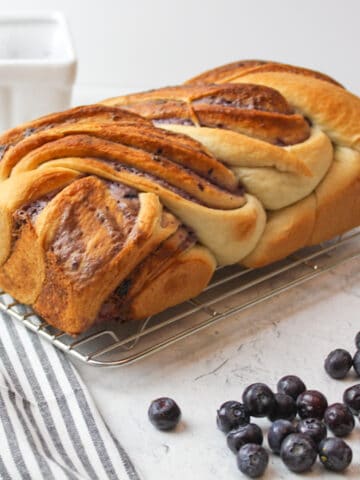

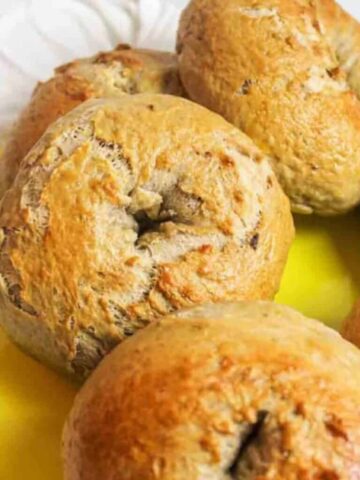

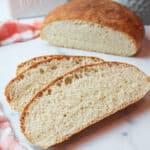


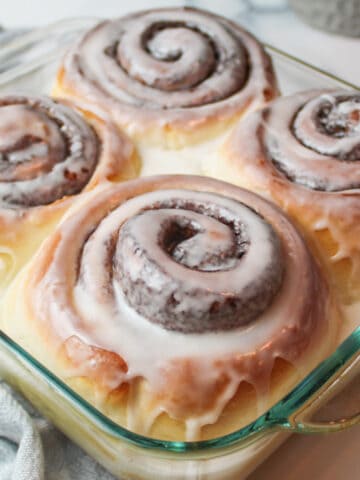
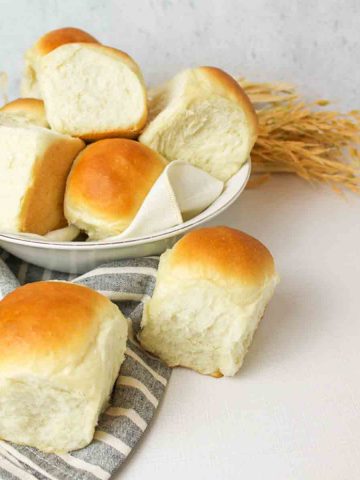
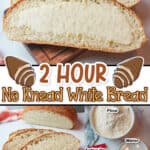
Comments
No Comments